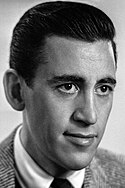J.D. Salinger Quote
While he was doing it, I went over to my window and opened it and packed a snowball with my bare hands. The snow was very good for packing. I didn’t throw it at anything, though. I started to throw it. At a car that was parked across the street. But I changed my mind. The car looked so nice and white. Then I started to throw it at a hydrant, but that looked too nice and white, too. Finally I didn’t throw it at anything. All I did was close the window and walk around the room with the snowball, packing it harder. A little while later, I still had it with me when I and Brossard and Ackley got on the bus. The bus driver opened the doors and made me throw it out. I wasn’t going to chuck it at anybody, but he wouldn’t believe me. People never believe you.
While he was doing it, I went over to my window and opened it and packed a snowball with my bare hands. The snow was very good for packing. I didn’t throw it at anything, though. I started to throw it. At a car that was parked across the street. But I changed my mind. The car looked so nice and white. Then I started to throw it at a hydrant, but that looked too nice and white, too. Finally I didn’t throw it at anything. All I did was close the window and walk around the room with the snowball, packing it harder. A little while later, I still had it with me when I and Brossard and Ackley got on the bus. The bus driver opened the doors and made me throw it out. I wasn’t going to chuck it at anybody, but he wouldn’t believe me. People never believe you.
Related Quotes
About J.D. Salinger
The Catcher in the Rye (1951) was an immediate popular success; Salinger's depiction of adolescent alienation and loss of innocence was influential, especially among adolescent readers. The novel was widely read and controversial, and its success led to public attention and scrutiny. Salinger became reclusive, publishing less frequently. He followed Catcher with a short story collection, Nine Stories (1953); Franny and Zooey (1961), a volume containing a novella and a short story; and a volume containing two novellas, Raise High the Roof Beam, Carpenters and Seymour: An Introduction (1963). Salinger's last published work, the novella Hapworth 16, 1924, appeared in The New Yorker on June 19, 1965.
Afterward, Salinger struggled with unwanted attention, including a legal battle in the 1980s with biographer Ian Hamilton and the release in the late 1990s of memoirs written by two people close to him: Joyce Maynard, an ex-lover; and his daughter, Margaret Salinger.
